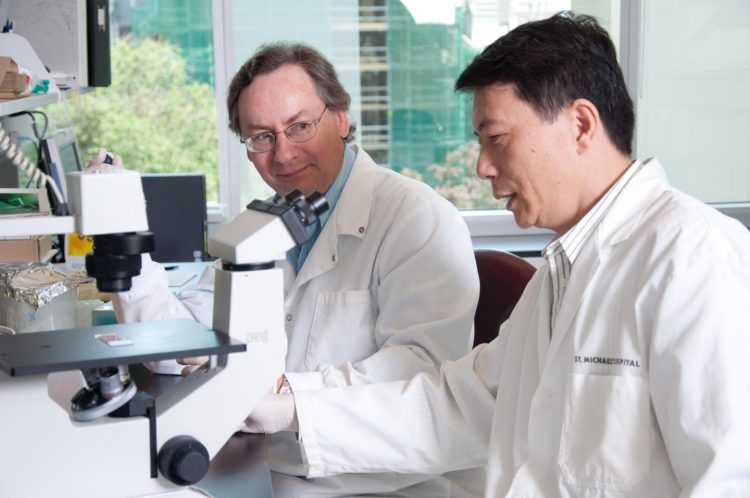Novel type 1 diabetes treatment shown to work on human beta cells transplanted into mice

A chemical produced in the pancreas that prevented and even reversed Type 1 diabetes in mice had the same effect on human beta cells transplanted into mice, according to a paper in the Dec. issue of Diabetes by Dr. Gerald Prud'homme (left) and Qinghua Wang (right) of the Keenan Research Centre for Biomedical Sciences of St. Michael's Hospital in Toronto. Credit: Courtesy of St. Michael's Hospital
A chemical produced in the pancreas that prevented and even reversed Type 1 diabetes in mice had the same effect on human beta cells transplanted into mice, new research has found.
GABA, or gamma-aminobutryic acid, is an amino acid produced by the same beta cells that make and secrete insulin.
Drs. Gerald Prud'homme and Qinghua Wang of the Keenan Research Centre for Biomedical Sciences of St. Michael's Hospital published a paper in 2011 showing for the first time that GABA injections not only prevented Type 1 diabetes in mice, but even reversed the disease.
A new paper published (Nov. 29) in the December issue of Diabetes shows GABA does the same thing in mice who have been injected with human pancreatic cells.
Type 1 diabetes, formerly known as juvenile diabetes, is characterized by the immune system's destruction of the beta cells in the pancreas. As a result, the body makes little or no insulin. The only conventional treatment for Type 1 diabetes is insulin injection, but insulin is not a cure as it does not prevent or reverse the loss of beta cells.
Drs. Prud'homme and Wang also found that GABA vastly improved the survival rate of pancreatic cells when they were being transplanted into mice. About 70 per cent of pancreatic cells die between the time the organ is harvested and transplanted. The researchers said their finding could lead to future research specifically related to pancreatic transplants.
GABA has been known for decades to be a key neurotransmitter in the brain, a chemical that nerve cells use to communicate with each other, but its role in the pancreas was unknown until the 2011 paper by Drs. Prud'homme and Wang.
GABA and related therapies would have to be tested in human clinical trials, a process that could take several years, the researchers said, noting that many treatments that work in mice do not always translate into effective human therapies.
This study received funding from the Juvenile Diabetes Research Foundation and the Canadian Institutes for Health Research.
About St. Michael's Hospital
St. Michael's Hospital provides compassionate care to all who enter its doors. The hospital also provides outstanding medical education to future health care professionals in more than 23 academic disciplines. Critical care and trauma, heart disease, neurosurgery, diabetes, cancer care, and care of the homeless are among the Hospital's recognized areas of expertise. Through the Keenan Research Centre and the Li Ka Shing International Healthcare Education Centre, which make up the Li Ka Shing Knowledge Institute, research and education at St. Michael's Hospital are recognized and make an impact around the world. Founded in 1892, the hospital is fully affiliated with the University of Toronto.
For more information, or to speak to Drs. Prud'homme or Wang, please contact Leslie Shepherd, Manager of Media Strategy.
Inspired Care. Inspiring Science.
http://www.stmichaelshospital.com
Follow us on Twitter: http://www.twitter.com/stmikeshospital
Media Contact
All latest news from the category: Life Sciences and Chemistry
Articles and reports from the Life Sciences and chemistry area deal with applied and basic research into modern biology, chemistry and human medicine.
Valuable information can be found on a range of life sciences fields including bacteriology, biochemistry, bionics, bioinformatics, biophysics, biotechnology, genetics, geobotany, human biology, marine biology, microbiology, molecular biology, cellular biology, zoology, bioinorganic chemistry, microchemistry and environmental chemistry.
Newest articles

NASA: Mystery of life’s handedness deepens
The mystery of why life uses molecules with specific orientations has deepened with a NASA-funded discovery that RNA — a key molecule thought to have potentially held the instructions for…

What are the effects of historic lithium mining on water quality?
Study reveals low levels of common contaminants but high levels of other elements in waters associated with an abandoned lithium mine. Lithium ore and mining waste from a historic lithium…

Quantum-inspired design boosts efficiency of heat-to-electricity conversion
Rice engineers take unconventional route to improving thermophotovoltaic systems. Researchers at Rice University have found a new way to improve a key element of thermophotovoltaic (TPV) systems, which convert heat…



